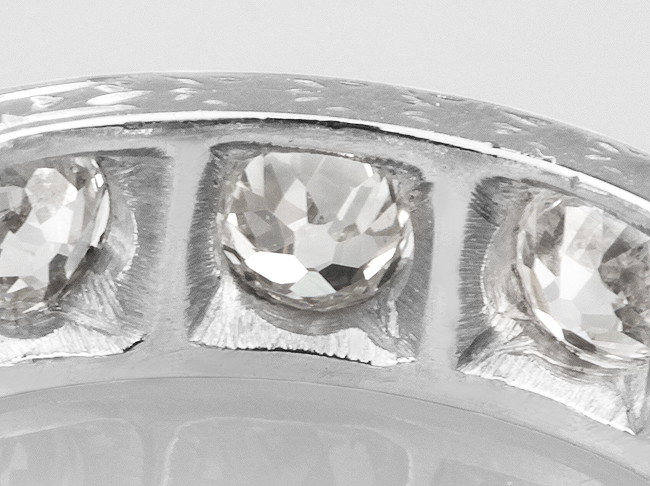A guide to older diamond cuts and vintage diamonds.
Earlier this week, I refurbished two items of jewellery.
Both antique rings featured Old Cut diamonds.
Antique diamonds fascinate collectors and antique dealers. But do you know how to identify an antique diamond cut? Few buyers recognise a modern cut from an old cut.
Today, most old cuts come from antique jewellery.
Buyers look for large antique diamonds to re-cut with better proportions. By doing this, older diamonds fall in line with current prices.
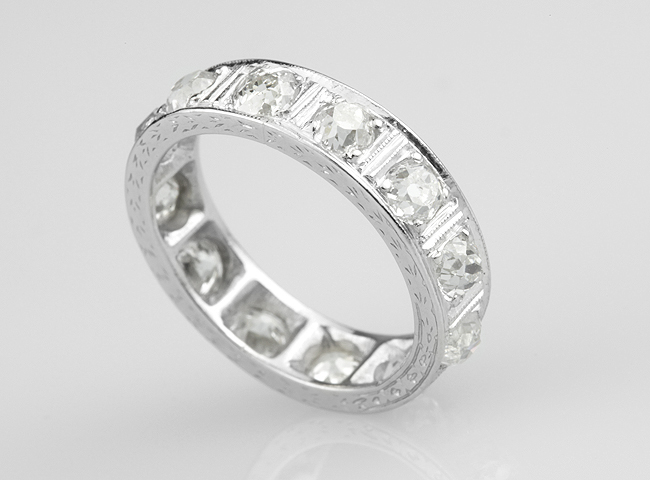
Antique eternity ring. Note the small table facet, lack of symmetry and extra depth for each diamond.
Interestingly, we resized this old cut eternity ring making it larger. Firstly, we removed the diamonds. Next, we added a section to the ring. Then, we matched a new (old) diamond to the ring. Finally, we set all of the diamonds in place.
What are old-cut diamonds?
The term refers to antique diamonds cut without the precision of modern cut diamonds. Other descriptions include ‘Old Mine Cut’ and ‘Victorian Cut.’
Most old diamonds appear thicker with high crowns compared to modern diamonds. In addition, old cuts sparkle less due to a lack of symmetry. Light simply passes through poorly cut diamonds. So why would anyone want an old cut?
Old-cut gemstones offer vintage charm—a connection to a bygone era. Many Victorian cut diamonds feature in charming jewellery styles; from antique diamond rings to Victorian diamond brooches.
Where to buy antique diamond cuts
Many years ago, during my career at a diamond merchant, we carried a parcel of antique gems. They originated from various sources. Some came from scrapped jewellery. We regularly dipped into this parcel to match up the missing diamonds.
Part of our work involved ‘jobbing.’ Retailer jewellers sent rings missing diamonds. Our work involved matching up diamonds by shape, colour and clarity. We found the best match possible to restore the jewellery and make it wearable again.
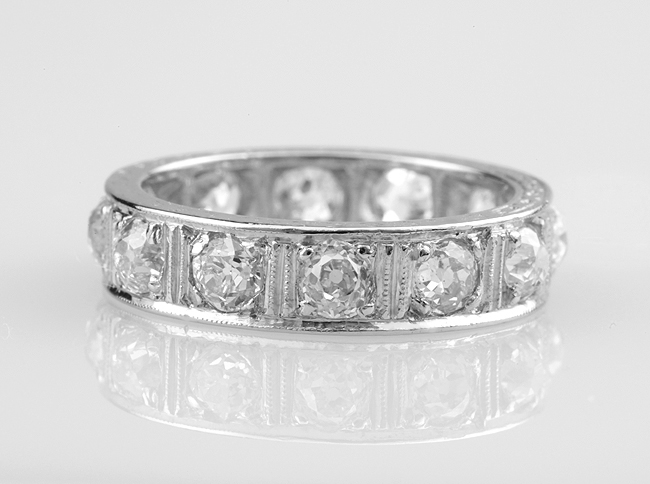
In the above image, the distinctive polished culet of each diamond appears through the stone. This circular shape typifies the look of an old cut diamond.
Characteristics of old and vintage diamond cuts
The term ‘Old Mine Cut’ applies to many of the diamonds cut before the 18th Century.
Before the process of bruting, many of the examples assumed a square shape, appearing like the forerunner of the Cushion Cut.
Diamonds possessed a polished culet with far greater depth than most modern cut diamonds.
Old European cuts presented a far rounder shape, with a differing arrangement of facets.
Some older cuts of diamonds fall under the term’Victorian Cut’ feature tell-tale characteristics. These include:
Deep proportions – diamonds appear thicker than modern round brilliants.
Small table facets – a small and tall table facet on the top of the diamond.
A polished culet – The bottom facet of the underside (Pavilion) known as the culet appears as a flat polished facet.
The Old European Cut Diamond
Old European cut diamonds, a captivating relic from the late 19th and early 20th centuries, embody the grace of a bygone era.
Distinctive for their chunky facets and smaller tables, these diamonds emanate a warm, romantic glow that sets them apart in a world of modern cuts.
Each facet tells a story of meticulous craftsmanship, a testament to the skilled hands that shaped them when precision was an art form.
The Old European cut, with its nostalgic charm, invites admiration for its imperfections, celebrating the allure of history encapsulated in the brilliance of these timeless gems.
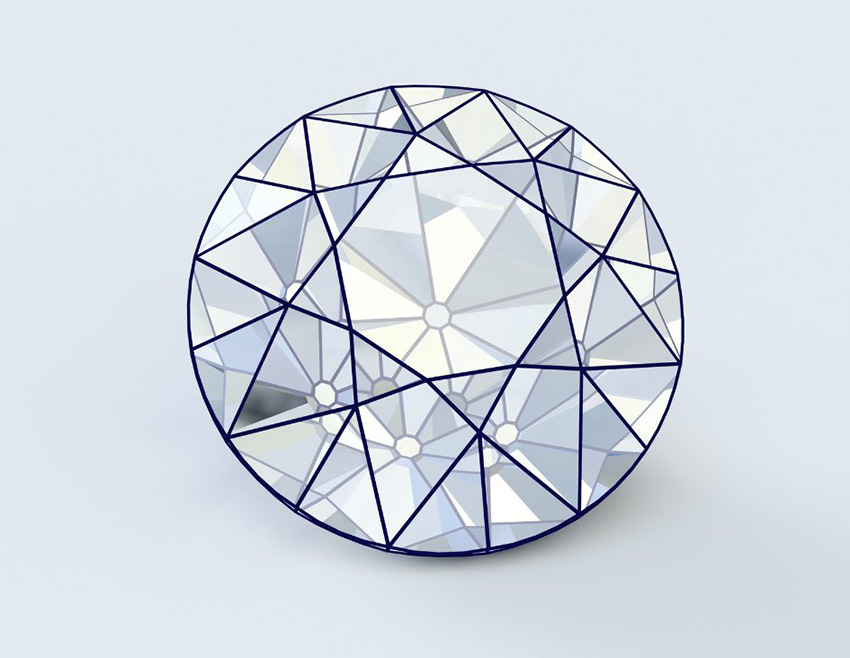
If you look at the image below, you will see the flat polished culet on the underside of the diamonds. From the opposite side (the table) you will see this as a small circle, viewed from the top of the diamond.
In the following video by GIA, we see the evolution and characteristics leading to modern variations.
Where to source antique stones
As part of our service, we source most diamonds for clients. Owing to the limited availability of old cuts, we use our network of suppliers and merchants to source suitable stones.
Although many Victorian cut diamonds demand lower prices than modern stones, scarcity often sets their price above modern stones.
Less choice exists in terms of colour and clarity compared with modern stones.
Another feature of vintage diamonds includes wear. For example, many old cuts possess nibbled edges; small nicks and chips out of the stone’s girdle. Such wear comes from several lifetimes of setting and unsetting.
Some damage can be removed by repolishing older diamonds without reducing the overall carat weight. We assess each diamond on an individual basis for this reason.
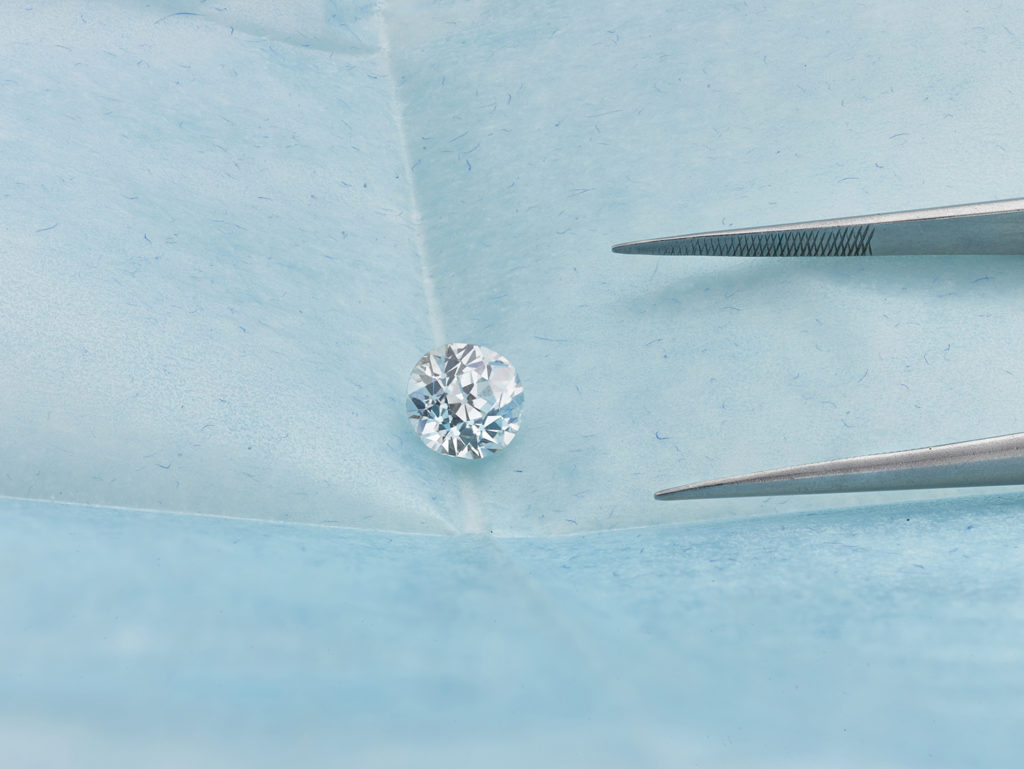
Remodelling diamond rings with antique diamonds
From time to time, we re-model antique rings and vintage jewellery designs.
Working with a client’s own diamonds, we craft new ring styles, using old diamonds. The following example shows small old cuts with high table facets, surrounding a large oval opal.
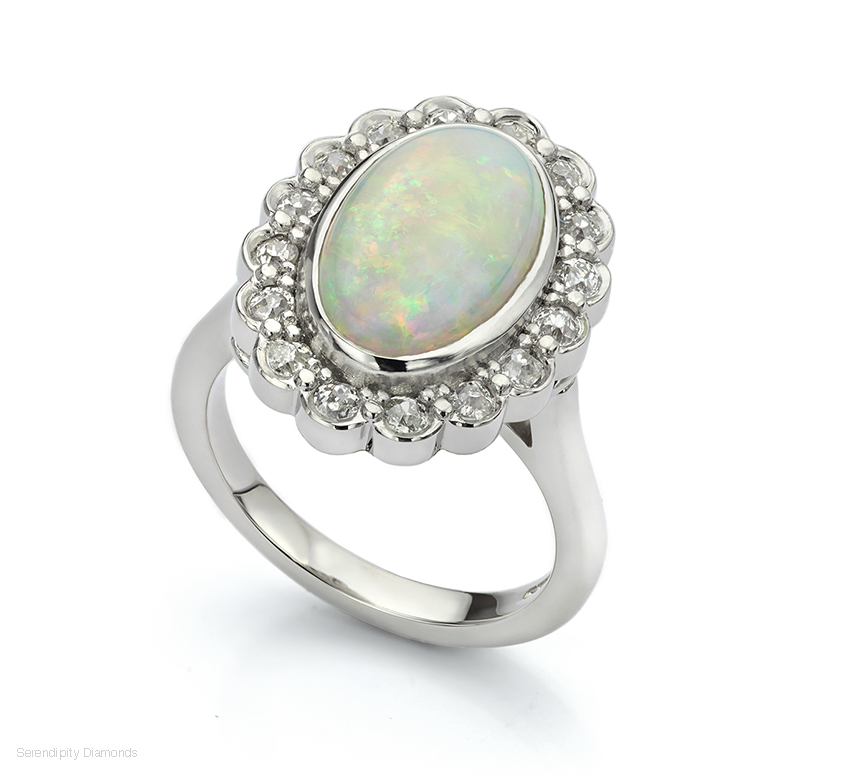
Antique diamond engagement rings with new settings
Part of our work involves un-setting large antique diamonds. We set inherited diamonds and family heirlooms into new ring mounts. This service appeals to younger couples. Many inherit an engagement ring and prefer to wear a modern setting.
In addition, many older diamond engagement rings exist in thin, worn or poorly made settings. For this reason, we provide a service to cherish an original diamond added to a new ring mount.
The following antique diamond solitaire engagement ring would benefit from a remount.
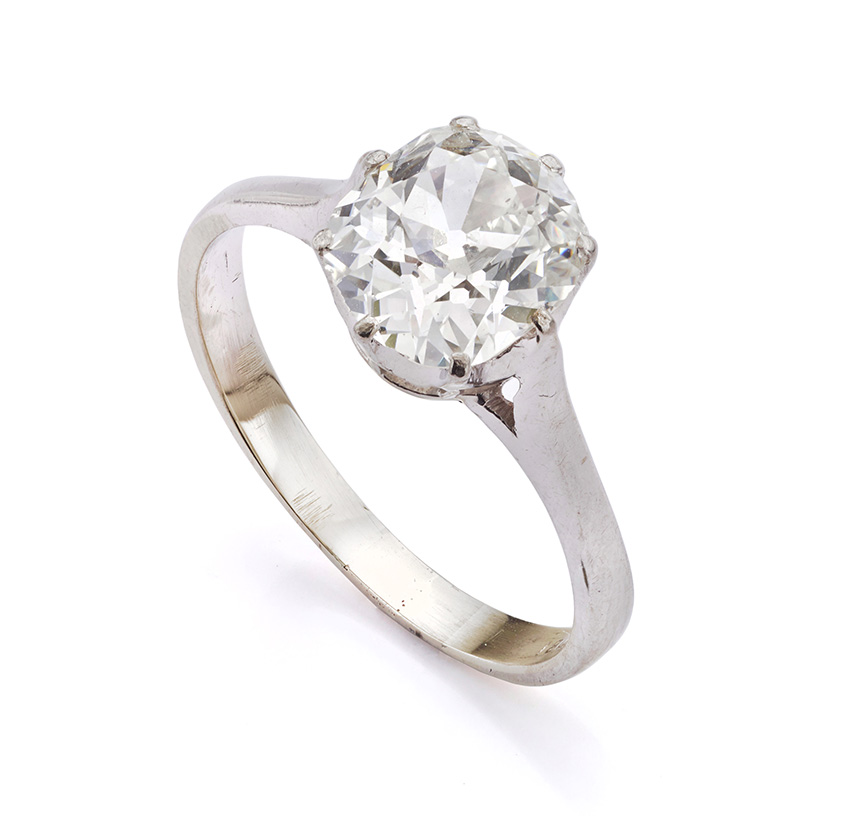
With its beautiful antique diamond, this solitaire ring would benefit from a brand-new ring mount, made in Platinum. Note the worn claws no longer provide security for the diamond.
1 Carat Old Cuts
Large vintage diamonds benefit from recutting into modern diamonds. For example, an old cut weighing 1.15 carats will retain its 1-carat weight when recut. Owners sacrifice this weight to remodel the stone into a modern cut. The value of the final diamond can far exceed the original purchase price.
Recutting often improves proportions, light performance, and the overall value of the stone.
The diamond below shows a nicely proportioned Old European Cut, with a small polished culet, and fairly shallow proportions. The stone is just under 2 carats in weight and measures 7.5mm in diameter.
Set into the original ring design with a natural patina, we recommend leaving any such item alone. A huge market exists for pre-owned or cherished jewellery. An enormous demand exists for genuine antique or vintage jewellery designs.
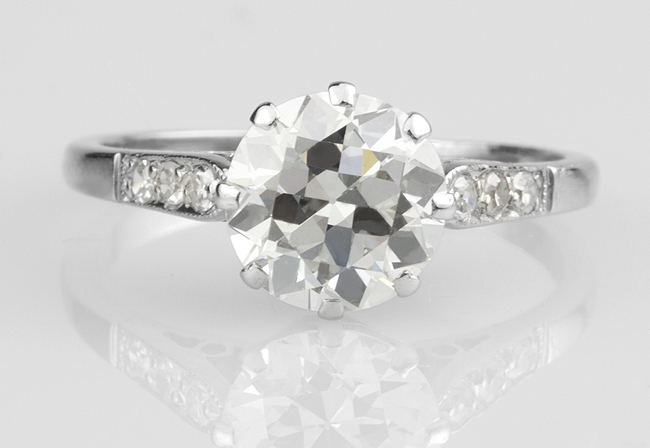
Old European cut diamond, proportioned with a smaller polished culet.
Other styles of antique diamond cuts
Other diamond shapes exist from the evolution of the cutting process.
For example, rose-cut diamonds. Rose-cut diamonds feature a flat base with simple faceting over their curved surface. With a shallow cut, rose-cut diamonds let light through the stone and benefit from a mirror back to reflect light.
Other diamond cuts include antique cushions and the original Asscher with deeper proportions to modern versions.
In addition, smaller diamonds fall into full-cut and single-cut categories. We cover the difference between single-cut (8-cut) and full-cut diamonds in our later blog post. Modern and antique versions exist for all such diamond cuts.
Older diamonds split the light spectrum, creating greater fire. In contrast, modern cuts dazzle with more obvious brilliance.
Further reading – Wikipedia has some interesting and useful information on Diamond Cuts, including a paragraph on their history.
A timeline of diamond cuts
We recently received a great suggestion in our comments section about adding a timeline of diamond cuts to the article. As a result, we put together a very short and simple table to show the development of diamond cuts through the ages.
| Time Period | Diamond Cut | Characteristics | Geographical Locations |
|---|---|---|---|
| 14th Century | Point Cut | Rough diamonds used in jewelry | India, Middle East |
| 16th Century | Table Cut | Flat table on top, pointed or rounded pavilion | Europe |
| 17th Century | Rose Cut | Flat bottom, dome-shaped crown | Europe, India |
| 18th Century | Old Mine Cut | Cushion-shaped, high crown, small table, chunky facets | Europe, South America |
| 19th Century | Old European Cut | Round cut, larger table, lower crown, larger facets | Europe, United States |
| 20th Century | Modern Brilliant Cut | Developed in 1919 by Marcel Tolkowsky | Worldwide |
| 20th Century | Fancy Cuts | Princess, emerald, marquise, pear, heart, etc. | Worldwide |
| Present Day | Contemporary and Custom Cuts | Ongoing evolution in cutting techniques | Worldwide |
About Mark Johnson
Mark founded Isle of Wight jewellers Serendipity Diamonds in 2007 after a career on the polished diamonds industry. Today he works in the Serendipity showroom, helping clients with jewellery, creating handmade designs and updating their two jewellery websites SerendipityDiamonds.com and Isle-of-Wight-Jewellery.co.uk



